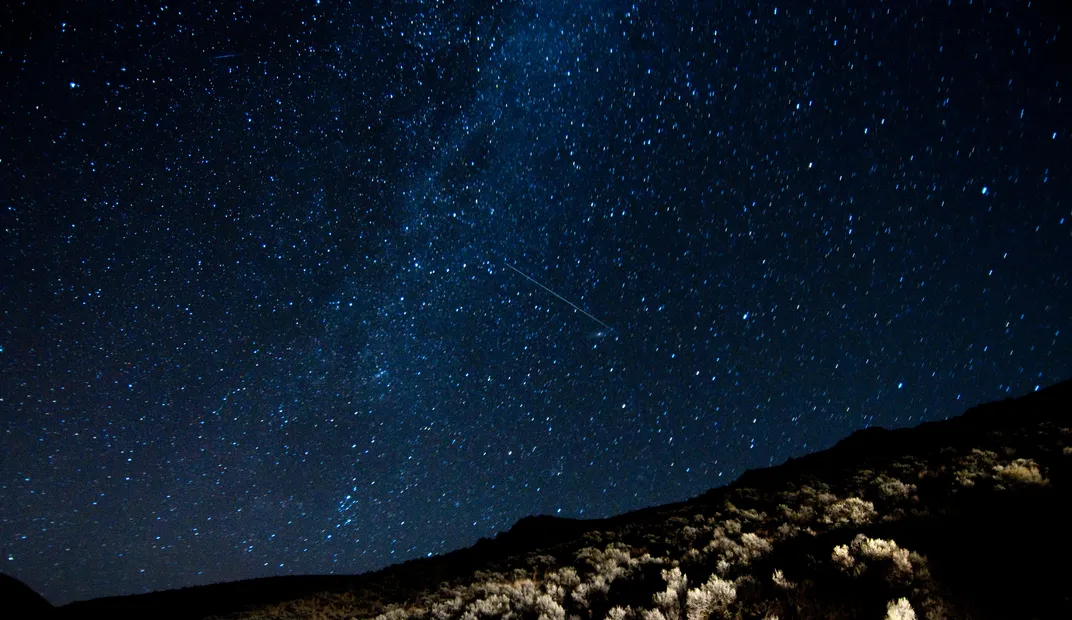How to Catch a Glimpse of the Draconid Meteor Shower
While the annual shower usually makes for a sleepy showing, it has been known to produce fantastic outbursts in the past
:focal(1470x889:1471x890)/https://tf-cmsv2-smithsonianmag-media.s3.amazonaws.com/filer_public/b0/1e/b01ebe59-7c87-4e0b-9809-f82de86c5664/gettyimages-128795552.jpg)
Soon, the dragon constellation Draco will appear to breathe—or more accurately, sparsely cough—meteors across the sky. From October 6 to 10, sky watchers will have the opportunity to witness the Draconids, one of the most well-known, and most capricious, meteor showers.
The best place to watch the Draconids will be at night in the Northern Hemisphere. The meteor shower is estimated to peak on the evening of October 7 to just before dawn on October 8, when viewers could spot up to ten meteors per hour under ideal conditions.
If you’re hoping to watch the celestial show, head outside after dusk: The constellation Draco—which is the shower’s radiant, or the spot where the meteors seem to emanate from—will be highest in the sky at nightfall, according to EarthSky.
The Draconids are often known for being a weak shower, moving at about 21 kilometers per second, which is slow for meteors—the mid-November Leonid meteors, famous for their speed, clock in at 71 kilometers per second, for comparison. But in some years, the dragon “wakes” and showers the sky in a meteor storm, a dramatic celestial event in which observers report more than 1,000 meteors per hour. In 1946, watchers of the Draconids spotted 50 to 100 meteors per minute in the United States.
“The Draconids are what I call an all-or-nothing shower,” says Bill Cooke, the lead of NASA’s Meteoroid Environment Office, to Smithsonian magazine. “If there’s an outburst, it may be worth going out to see. But normal Draconid activity, they’re very faint, because they move so slowly. So, a normal Draconid year, you might see two to three meteors per hour, and that’s pretty much nothing.”
While the Draconids might be sleepy this time around, next year could bring a highly anticipated storm. Cooke estimates 2025 could see a strong outburst of Draconids, “but that will involve small particles, particles less than a millimeter in size,” which could make them tough for observers to spot.

The source of the Draconids is Comet 21P/Giacobini-Zinner, which orbits the sun every 6.6 years. The comet was first discovered on December 20, 1900, at the Nice Observatory in France by Michel Giacobini. It was later recovered by Ernst Zinner on October 23, 1913.
Named for both its discoverers, 21P/Giacobini-Zinner leaves a streaming trail of ice and rock in its wake as it traverses our solar system. When Earth passes through this path of particles each year, the grains burn up in our atmosphere, producing the annual Draconid meteor shower.
The reason for the Draconids’ capricious meteor storms can be traced all the way to Jupiter. The gravity of the large outer planets, specifically Jupiter for 21P/Giacobini-Zinner, can impact the trajectories of comets, Cooke says. In some years, this can tug the comet’s stream of debris closer to Earth and in other years push it farther away.
Predicting meteor showers is another challenge. The work of NASA’s Meteoroid Environment Office includes generating meteor shower forecasts to protect astronauts and spacecraft from hazardous meteoroids, which Cooke calls a “kind of complex celestial mechanics problem.”
For example, the Draconids produced an outburst in 2012 that scientists didn’t predict. Astronomers don’t expect this year to put on a particularly dramatic show. But the possibility that the Draconids could unleash a meteor storm “keeps many skywatchers outside—even in moonlight,” writes EarthSky.
Meteor storms are “once-in-a-lifetime opportunities,” Nick Moskovitz, an astronomer at Lowell Observatory in Flagstaff, Arizona, tells Smithsonian magazine. “These are rare events. You kind of have to be in the right place at the right time, with clear skies and all that.”
With the predicted storm next year, Moskovitz says, he “definitely will be paying close attention.”
Discovering comets and new meteor showers is also a tricky business. For some annual meteor showers, like the Southern Delta Aquariids, scientists still do not know exactly which comet produces the annual shower. Moskovitz adds that only a small fraction of meteor showers have a known parent body.
“I think in the coming years, as we get better at discovering more and more comets and asteroids out there in the solar system, we’ll be able to better understand that link between the annual meteor showers and their parents in space,” he says.
If you do try to catch the Draconids this coming week, patience will be your friend—as well as a snack, a seat and a jacket if it’s cold. Check your local forecast before heading outside, and look to skywatch in a location with minimal light pollution. With luck, you may be able to catch a glimpse of the fickle Draconids.